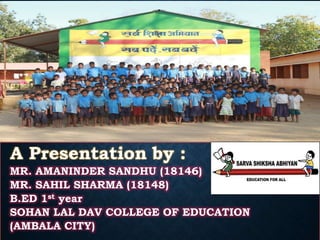
SARV SHIKSHA ABHIYAN ,2002
- 1. A Presentation by : MR. AMANINDER SANDHU (18146) MR. SAHIL SHARMA (18148) B.ED 1st year SOHAN LAL DAV COLLEGE OF EDUCATION (AMBALA CITY)
- 2. PRESENTING TO : MR. PAWAN KUMAR ( Assistant Professor ) SOHAN LAL DAV COLLEGE OF EDUCATION AMBALA CITY
- 3. OVERVIEW • Perspective of SARVA SHIKSHA ABHIYAN • Aims and Objectives of S.S.A • S.S.A as a framework and as a programme • Implementation strategies and planning process of S.S.A • Public –private partnership in S.S.A
- 4. BACKGROUND OF S.S.A • In 1990 (5-9 March) a world conference attended by delegates from 155 countries and representatives of some 150 governmental and non governmental organisations held in Jomtien (BANGKOK) • The agenda was to make primary education accessible to all children and eradicate illiteracy before the end of the century • The conference adopted the World Declaration on Education for all which reaffirmed the education as a fundamental right
- 5. Why SSA? • Many efforts have been done in the field of Education since last many years in India. • However, much needed to be done for the special focus groups, and the upper primary sector. • Quality improvement still remained a major concern. • An attempt to fill the vacuum and covers all the districts.
- 6. SARVA SHIKSHA ABHIYAN • launched in 2002 by ATAL BIHARI VAJPAYE • attain Universal Elementary Education (UEE) • aimed to provide useful and relevant, elementary education to all children in the 6 to 14 age group by 2010. • lays emphasis on bridging all gender and social category gaps at elementary education level • umbrella programme covering other programmes
- 8. CHARACTERISTICS OF S.S.A 1. Based on Universality 2. Participation of other institution 3. To produce National Integration 4. Establishment of Social Justice
- 9. 5. Right of education 6. Improvement of quality education 7. Certain Time-Table 8. Collaboration of Center & State Govt. 9. Improve Panchayti Raj System/Effective involvement of Local Bodies
- 10. MAIN OBJECTIVES OF S.S.A POLICY 1. Eight years of Quality Education 2. To fill the gap between regions and gender inequality 3. Maximum community participation through Education 4. To develop values through Education 5. Take care and Development of early state Children 6. Educate child in lap of Nature 7. Remove social and regional differences 8. Improve Quality of education at National level
- 11. OBJECTIVES • All children in school , education gurantee- centre , alternate school ,back to school camp by 2003 • All children complete five years of schooling by 2007 • All children complete eight years of elementary schooling by 2010
- 12. SARVA SHIKSHA ABHIYAN AND EDUCATIONAL FACILITIES (IMPLICATIONS) 1. S.S.A Policy provides educational facilities to schools by selection of teachers. 2. There should be ratio of 1:40 students of one in the class 3. There should be one school in 1 K.M distance of child’s home. 4. S.S.A policy draws the attention of formulation of classroom
- 13. IMPLICATIONS 6. Free text books 7. Supervision of school building 8. Funds to provide on the basis of physical resources 9. Funds for teachers 10.Funds regarding teaching learning materials 11.To give training to teachers 12.To provide learning facilities to disabled children
- 15. MAJOR CENTRAL INTERVENTIONS AND THEIR INTEGRATION WITH S.S.A • Operation blackboard (a) Under NPE(National Policy On Education) 1986 • Teacher education (a) S.S.A will include new appointments of the teachers. • Non formal education for disabled children.
- 16. MAJOR CENTRAL INTERVENTIONS AND THEIR INTEGRATION WITH S.S.A • Mahila Samakhya. (a) Great success in the field of women education has been achieved through program like Mahila Shiksha. • DPEP (District Primary Education Programme) • Mid-day meal programme.
- 17. PROVISION UNDER S.S.A • Intervention for early child care and education • Mahila Samakhya like interventions from the innovation fund • Provision of process-based community participation • School/EGS( Education guarantee scheme) like alternative facility for education • Upgardation of EGS to regular schools
- 18. CONTINUED... • Free textbooks to all girls/SC/ST children as at present • Mid day meal programme • At least 50% taechers to be appointed have to be women • Provision for school and teacher grants • Provision for 20 days in-service each year for all teachers • Provision for all children with special needs
- 19. TOTAL NUMBERS OF SCHOOL INCREASED FROM : 8,53,601 in 2002-03 To 12,85,576 in 2008-09 Increase of 4,31,975 about 50% increase from 2002-03
- 20. SHARE OF GIRLS ENROLMENT UNDER S.S.A •Primary classes 48.38% •Upper primary classes 47.58%
- 21. SUGGESTIONS TO IMPROVE/STRENGTHEN OF THE S.S.A • Must give free books and other incentives to disabled children • Incentives should give also to all the students • Mid day meal will be provided to all the students • Pre service training of the teachers should be changed from time to time • The govt. should make some appropriate policies to measure the functions of govt.
- 22. CONTINUED… • by reducing dropouts of school children • The Right to Education Act to be implemented by all states • by improving teacher and student attendance • by improving the Quality of Education • by improving the school environment
- 23. CONCLUSION • S.S.A has adopted a more expansive and broad based program understanding the concept of inclusion wherein multi model techniques for imparting education . The main aim of modern education is to provide knowledge to youth rather than certificates . Education is an important tool of success. It teaches us art of living .We cannot learn easily about that knowledge which is not according to our mind and ability CONCLUSION
